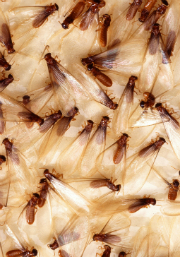What should I expect from termite inspections?
 Termites are one of the insects that I get questions about most often, expecially from new home owners. Many people want to know how dangerous they are, how much damage they can do, how often they should get a free termite inspection, if they should treat it now, how much the treatments are…all sorts of questions. The challenge is, termite risks can vary greatly, and the cost of treatment can as well. The best advice I have for anyone who has a question about termites is have your house inspected. Which leads me to my first point about what you should expect from a termite inspection; it should be free. If a treatment is needed, that will be where cost is discussed, but where I live, in Austin Texas, you should be able to contact a pest control company and receive a free termite inspection pretty easily.
Termites are one of the insects that I get questions about most often, expecially from new home owners. Many people want to know how dangerous they are, how much damage they can do, how often they should get a free termite inspection, if they should treat it now, how much the treatments are…all sorts of questions. The challenge is, termite risks can vary greatly, and the cost of treatment can as well. The best advice I have for anyone who has a question about termites is have your house inspected. Which leads me to my first point about what you should expect from a termite inspection; it should be free. If a treatment is needed, that will be where cost is discussed, but where I live, in Austin Texas, you should be able to contact a pest control company and receive a free termite inspection pretty easily.
A good termite inspectior looks for three basic things
- Current activity
- Past Activity
- Potential access (and they will likely refer to that as a conducive condition)
Current activity would be actual termite and their mud tubes. The tubes are thin, usually not wider than 1/4 inch, and termites use them as tunnels to get from the soil to the structure. By breaking them open you will be able to see termites if they are active. If you don’t see termites, its unlikely that tube is active.
Past activity is just old damage, and it tells us if there has been an issue with termites in the past. Because termites are not the only wood destrying inscet, its critical to distinguish between termite damage and other wood destrying insect damage like carpenter ant damage for instance.
Potentail access is avaliable in every structure, but its the trickiest to talk about. There are tons of variables, and in every structure there are going to be areas that are not accessible to an inspector. Termites can access spaces as narrow as 1/32 of an inch. They can’t go directly through the concrete of a monolythic slab, but any place where concrete was poured around something, how plumbing is generally run, termites can use that space as an access point. Also any time a slab foundation is cracked, that crack provides enough space for a termite access point. In these cases, in which visible access to the access point itself is not avaliable, what an inspector is typically looking for is damage, because the problem isn’t visible until the structure is in fact damaged. Becasue of this, some people who have a lot of inaccessible areas like to take a preventative approach and treat. The ongoing inspection is still important, but you are simply less likely to have an issue if the structure is treated. In additional to the hidden areas, termites can use fences, decks, and soil that is at a higher grade than the siding, just to name a few.
Basically what you should expect from a termite inspection is a thurough inspection of your home for current activity, past damage and for potential access. At that point, a professional pest control person would be able to clarify what sorts of risks termites pose to your home and you can make an informed decision about how to prevent or stop termite damage.
I hope it was a helpful overview. Feel free to comment with questions, I’m always happy to answer them.
Thanks for reading!
